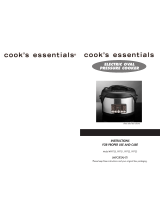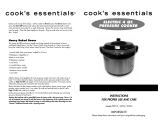
INSTRUCTIONS FOR USE
Raising to full pressure:
First steam escapes through the red locking indica-
tor (9), see Fig. a. As soon as pressure starts to
build up, however slight, the locking indicator
rises and locks the lid. (Opening the lid is now
impossible until the pressure has been safely
released).
Wait until a steady flow of steam escapes through the cooking regulator valve, accom-
panied by a loud hiss, see Fig. b. The cooker is now at full pressure. Lower the source of
heat to maintain a gentle, steady release of steam. Leave to operate for 20 minutes.
(Reduce the heat sufficiently to hear a steady muttering sound with a gentle flow of
steam. If the heat is too high, there is a constant loud hissing. If the heat is too low,
there is little or no noise).
Warning: It is not recommended that the cooker is left unattended during use.
Remember during cooking you may need to adjust the heat level.
Note: If the locking indicator drops down during cooking, increase the heat a little and
extend the cooking time.
If the cooking regulator turns to the "release position" during cooking, it could mean
either the heat is too high or the pressure cooker has boiled dry.
Never remove the cooking regulator until the pressure has been released.
Condensed water may collect around the centre pipe under the cooking regulator valve
which is normal.
Releasing the pressure and opening the lid:
Turn off the heat source and slowly turn the cooking regulator
valve anti-clockwise. The more the valve is turned the more
steam escapes. When all the steam is released and there is no more
pressure, the red locking indicator drops down and the lid can be opened.
Empty the pan. Rinse and dry the pan and lid. Your pressure cooker is
now ready for cooking.
INSTRUCTIONS FOR USE
Opening the lid:
Hold the lid handle (4) with one hand and hold the pan handle
(13) with the other hand. Push the lid release plate (3) for-
wards and at the same time, turn the lid to the right as far
as it will go. Lift off the lid.
Place the regulator valve on the lid:
Press it down firmly onto the centre pipe (2) in the position shown on the
diagram. The coloured stripe on the regulator must be in line with the
red arrow on the lid. This is the "cooking position".
Sensor is supplied with two cooking regulator valves:
• red stripe (13 lb): fast cooking.
Ideal for most foods especially meat, and for defrosting.
• green stripe (8 lb): steaming and low pressure cooking.
Ideal for delicate foods such as fish or when steaming.
Closing the lid:
Place the lid (5) onto the pan so that the arrow on the lid
is opposite the arrow on the pan handle. Hold the
handles as shown in the diagram. Turn the lid handle to the left.
A "click" indicates it is properly closed. If the pressure cooker is
not properly shut there will be no build up of pressure.
Warning: To ensure safe operation, it is important to follow
these instructions for closing the lid.
Place the pressure cooker on the most powerful heat setting:
Put on to a high heat. Do not allow heat, especially a gas flame, to come in contact
with the handles. Position the cooker so that the steam outlet on the cooking regulator
valve is away from you.
2 3
a b
SENSOR UK 0048017 9/02/00 17:43 Page 3














